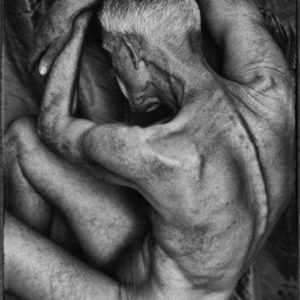Peter Jonas, an object in art
mainAs we mourn Peter’s death, here’s a reminder of the unsparing portraits he sat for in 2018 for a photographic exhibition by Barbara Luisi.

That was Peter, always giving his all.
This is what he wrote when Barbara showed him the pictures:
Gnarled olive trees and the ageing human body: two facets
of nature that show the glories of creation in their stark
reality of withering maturity. They are visual life histories
of nature and humanity in their inevitable but beauteous
decline.
Barbara Luisi is possessed of the talent and insight to show
the glorious but sinewy and tough reality of longevity
itself. They document the scars of experience. Free from
any cosmetic make-over and touched by the harsh beauty
of grainy naturalism, her pictures show us as we are and
nature as it is. They also show us what we might become
and how we will be seen when the final curtain falls, as it
always does!
PJ
14 th January 2019.






Farewell to a great man indeed – any public message from ENO yet? No, thought not…. shameful, considering what he did for them.
https://eno.org/news/everyone-at-eno-is-extremely-sad-to-learn-that-sir-peter-jonas-ceo-from-1985-to-1993-has-passed-away/
Why??? It is bizarre. And that is not a matter of taste.
I find it magnificenr, as was the man. And, yes, it is a matter of taste, and no, it is not bizarre.
That photo seems to me to stand honorably in the tradition of memento mori.
Memento Moris (mementos mori?) are never about real people, for obvious reasons.
Actually that is not true. Check your sources.
“During the same period there emerged the artistic genre known as vanitas, Latin for “emptiness” or “vanity”. Especially popular in Holland and then spreading to other European nations, vanitas paintings typically represented assemblages of numerous symbolic objects such as human skulls, guttering candles, wilting flowers, soap bubbles, butterflies and hourglasses. In combination, vanitas assemblies conveyed the impermanence of human endeavours and of the decay that is inevitable with the passage of time. See also the themes associated with the image of the skull.”
A ‘vanitas’ work of art seldom depicted a real person, as in a portrait, with the same meaning as a vanitas or portrait. It was never about individual people but about a universal notion of the limited life time every individual has. It was a symbol of a universal notion.
It is wholeheartedly to be recommended to first understand the subject before criticizing – in short: first check your sources.
https://en.wikipedia.org/wiki/Memento_mori
If we didn’t know who the subject was, the photograph could be taken as representative of man in general — as Jonas himself wrote, as an image of longevity or, as I see it, of mortality.
Standing in a tradition allows for expansion of the tradition.
This is the saddest news! He was a dear friend who was extraordinarily courageous and under his reign the English National Opera experienced its golden years with so many memorable productions. He will be sorely missed by all of us who loved him. May he rest in peace…
I don’t mean to question Peter Jonas’ courage or his thoughful comment. Far from it.
Yet Barbara Luisi deserves way more credit for these pictures than her overall admirable model.